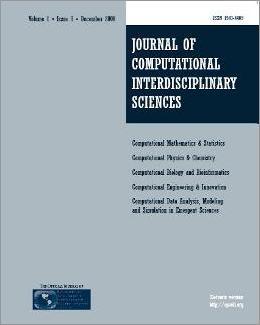
Editorial Office:
Management:
R. S. Oyarzabal
Technical Support:
D. H. Diaz
M. A. Gomez
W. Abrahão
G. Oliveira
Publisher by Knobook Pub


Editorial Office:
Management:
R. S. Oyarzabal
Technical Support:
D. H. Diaz
M. A. Gomez
W. Abrahão
G. Oliveira
Publisher by Knobook Pub
doi: 10.6062/jcis.2012.03.01.0050
(Free PDF)Güell O., Sagués F., Basler G., Nikoloski Z., and Serrano M. A.
Complex networks have been shown to be robust against random structural perturbations, but vulnerable against targeted attacks. Robustness analysis usually simulates the removal of individual or sets of nodes, followed by the assessment of the inflicted damage. For complex metabolic networks, it has been suggested that evolutionary pressure may favor robustness against reaction removal. However, the removal of a reaction and its impact on the network may as well be interpreted as selective regulation of pathway activities, suggesting a tradeoff between the efficiency of regulation and vulnerability. Here, we employ a cascading failure algorithm to simulate the removal of single and pairs of reactions from the metabolic networks of two organisms, and estimate the significance of the results using two different null models: degree preserving and mass-balanced randomization. Our analysis suggests that evolutionary pressure promotes larger cascades of non-viable reactions, and thus favors the ability of efficient metabolic regulation at the expense of robustness.
metabolic networks, robustness, cascading failure, null models.
[1] ALBERT R & BARABASI AL. 2002. Statistical mechanics of complex networks. Rev. Mod. Phys., 74: 47-97.
[2] DOROGOVTSEV SN, GOLTSEV AV & MENDES JFF. 2008. Critical phenomena in complex networks. Rev. Mod. Phys., 80: 1275- 1335.
[3] BARRAT A, BARTHELEMY M & VESPIGNANI A. 2008. Dynamical Processes on Complex Networks. Cambridge University Press, Cambridge.
[4] COHEN R, EREZ K, BEN-AVRAHAM D & HAVLIN S. 2000. Resilience of the Internet to Random Breakdown. Phys. Rev. Lett., 85: 4626-4628.
[5] ALBERT R, JEONG H & BARABASI AL. 2000. Error and attack tolerance of complex networks. Nature, 406: 378-382. [6] SZALAY MS, KOVACS IA, KORCSMAROS T, BODE C & CS ERMELY P. 2007. Stress-induced rearrangements of cellular net- works: Consequences for protection and drug design. FEBS Let ters, 581: 3675-3680.
[7] MOTTER AE, GULBAHCE N, ALMAAS E & BARABASI AL. 2008.Predicting synthetic rescues in metabolic networks. Molecular Systems Biology, 4: 168.
[8] SERRANO MA & SAGUES F. 2011. Network-based confidence scoring system for genome-scale metabolic reconstructions. BMC Systems Biology, 5: 76.
[9] PALSSON BØ. 2006. Systems Biology: Properties of Reconstructed Networks. Cambridge University Press, Cambridge.
[10] MA H & ZENG AP. 2003. Reconstruction of metabolic networks from genome data and analysis of their global structure for various organisms. Bioinformatics, 9: 270-277.
` [11] GUIMERA R & AMARAL LAN. 2005. Functional cartography of complex metabolic networks. Nature, 433: 895-900.
[12] SERRANO MA, BOGUNA M & SAGUES F. 2012. Uncovering the hidden geometry behind metabolic networks. Molecular BioSystems, 8: 843-850.
[13] HOLME P, LILJEROS F, EDLING CR & KIM BJ. 2003. Network bipartivity. Phys. Rev. E, 68: 056107.
[14] SMART AG, AMARAL LAN & OTTINO J. 2008. Cascading failure and robustness in metabolic networks. Proc. Natl. Acad. Sci. USA, 105: 13223-13228.
[15] GUELL O, SAGUES F & SERRANO MA. 2012. Predicting effects of structural stress in a genome-reduced model bacterial metabolism. Sci. Rep., 2: 621.
[16] MOLLOY M & REED B. 1995. A critical point for random graphs with a given degree sequence. Random Structures and Algorithms, 6: 161-180.
[17] NEWMAN MEJ, STROGATZ SH & WATTS DJ. 2011. Random graphs with arbitrary degree distributions and their applications. Phys. Rev. E, 64: 026118.
[18] NEWMAN MEJ, WATTS DJ & STROGATZ SH. 2002. Random graph models of social networks. Proc. Natl. Acad. Sci. USA, 99(suppl. 1): 2566-2572. [19] GUILLAUME JL & LATAPY M. 2006. Bipartite graphs as models of complex networks. Physica A Statistical and Theoretical Physics, 371: 795-813.
[20] BASLER G, EBENHOH O, SELBIG J & NIKOLOSKI Z. 2011. Mass-balanced randomization of metabolic networks. Bioinformatics, 27: 1397-1403.
[21] BASLER G, GRIMBS S, EBENHOH O, SELBIG J & NIKOLOSKI Z. 2012. Evolutionary significance of metabolic network properties. J.R. Soc. Interface, 9: 1168-1176.
[22] FEIST A et al. 2007. A genome-scale metabolic reconstruction for Escherichia coli K-12 MG1655 that accounts for 1260 ORFs and thermodynamic information. Molecular Systems Biology, 3: 121.
[23] SMIRNOV NV. 1948. Tables for estimating the goodness of fit of empirical distributions. Annals of Mathematical Statistics, 19: 279.
[24] DERISI JL, IYER VR & BROWN PO. 1997. Exploring the metabolic and genetic control of gene expression on a genomic scale. Sci- ence, 278: 680-686.